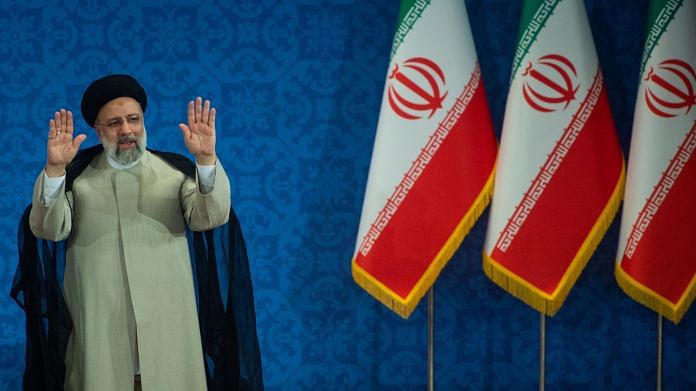Sometimes, the enemy of an enemy is an even greater enemy. For Iran, the humiliation of the U.S. in Afghanistan brings to the fore a fiercer foe. If the threat from the Taliban is not as existential to the Islamic Republic as the military presence of its most powerful adversary, the triumphant militia nonetheless poses a grave danger at an especially inconvenient moment.
Although Iran has stepped up its diplomatic outreach to the Taliban, the government of incoming President Ebrahim Raisi, facing growing discontent at home amid fading hopes of quick economic relief from the West, must now reckon with renewed perils in the east. The Taliban may have no interest in bringing down the Iranian regime, but its ascendancy in the Afghan civil war is sure to send fresh waves of refugees flooding across the 900-kilometer (560-mile) border between the countries, accompanied by a spike in drug and human trafficking, as well as increased terrorist activity.
It also endangers trade, which sanctions-shackled Iran can ill afford, and jeopardizes an ambitious railway project that would channel Afghan exports to Iranian ports, and thence to the wider world.
So any sense of schadenfreude in Tehran over President Joe Biden’s attempts to rationalize the American withdrawal from Afghanistan will have been stifled by the alarming news that the Taliban has taken control of Islam Qala, a key border post between the two countries. Reports from the area say Afghan security forces and customs officials fled to the Iranian side when the militia arrived.
Islam Qala is not only an important crossing point for bilateral trade, it is also the gateway to the Afghan city of Herat, the location of a large Iranian consulate. In 1998, militiamen allied with the Taliban slaughtered 11 Iranians there, including nine diplomats, bringing the two countries to within a whisker of war.
The Iranians and the Taliban managed to come to a modus vivendi, but relations remained hostile, and not only because of their competing sectarian world views: The mostly Sunni militiamen regard the Shiism of Iran as a heresy. When they ruled Kabul, the Taliban treated Afghanistan’s own Shiite minority with extreme brutality. They now claim to tolerate the sect, but terrorist groups that enjoy Taliban protection have stepped up attacks against Shiite targets.
The more practical-minded Taliban leaders have long recognized that Iran is a useful conduit to Western markets for Afghan opium, the militia’s main source of revenue. And it’s not their problem if some proportion of the drug falls off the back of the trucks to poison the Iranian population. As a direct consequence, Iran has one of the world’s highest rates of addiction.
That will almost certainly rise as the Taliban press home their advantage against Afghan government forces in the aftermath of the U.S. pullout. Needing more weapons and fighters, the militia will ramp up its opium exports. The effect will be felt in Iran long before it raises the anxieties of Western law-enforcement officials.
Iran is also home to over 750,000 Afghan refugees, and perhaps 2 million more who are undocumented. The guards and officials of Islam Qala will undoubtedly be joined by legions of others as fighting between the Taliban and Afghan government forces intensifies in the months ahead.
And then there’s terrorism. Although Iran has provided shelter and safe passage to top al-Qaeda leaders, it is regarded with implacable hostility by many other extremist groups allied to the Taliban. With the Americans out of the way, these groups will look farther afield for fresh targets. This is already raising alarms in China and Russia, but Tehran, by way of proximity and animosity, is the most vulnerable.
The more so because the regime has little leverage with the Taliban. For Iran, Afghanistan represents the weakest link in the network of proxies and partners through which it wields influence in its neighborhood. There is no Afghan equivalent of the Lebanese Hezbollah, the Houthi rebels in Yemen or the Shiite militias in Iraq. Although the Iranians have recruited Afghan refugees to fight — mainly to serve as cannon-fodder — in places like Syria, Tehran has never deployed them in their homeland. A suggestion by Iranian Foreign Minister Jawad Zarif that some of these fighters could help the Afghan government has been brusquely turned down.
Zarif’s offer can’t have escaped the attention of the Taliban leadership, however. Not that they need any reminding of what they regard as Iranian perfidy — from Tehran’s role in the creation of the anti-Taliban Northern Alliance in the late 1990s to its enthusiastic support for the U.S.-led invasion in 2001.
So, even as they smiled oleaginously at the Taliban leaders across the table in Tehran last week, the Iranians knew they were facing an old antagonist, newly reinvigorated. Those smiles will not last long. – Bloomberg
Also read: Now that US withdrawal has been achieved, China will move slowly on Afghanistan






